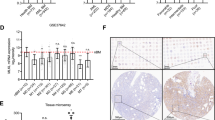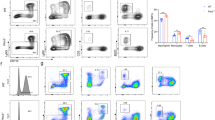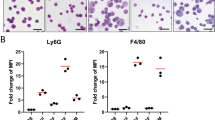Abstract
The SH2 domain-containing protein tyrosine phosphatase SHP-1 is expressed widely in the hematopoietic system. SHP-1 has been shown to negatively control signal transduction from many cytokine receptors by direct docking to either the receptor itself, or to members of the Jak family of tyrosine kinases which are themselves part of the receptor complex. Motheaten and viable motheaten mice, which are deficient in SHP-1, have increased myelopoiesis and show an accumulation of morphologically and phenotypically immature granulocytes, suggesting a role for SHP-1 in granulocytic differentiation. Here, we report that SHP-1 protein levels are up-regulated during the granulocyte colony-stimulating factor (G-CSF)-mediated granulocytic differentiation of myeloid 32D cells. Enforced expression of SHP-1 in these cells leads to decreased proliferation and enhanced differentiation, while introduction of a catalytically inactive mutant produces increased proliferation and results in a delay of differentiation. In vitro binding revealed that the SH2 domains of SHP-1 are unable to associate directly with tyrosine-phosphorylated G-CSF receptor (G-CSF-R). Furthermore, over-expression of SHP-1 in Ba/F3 cells expressing a G-CSF-R mutant lacking all cytoplasmic tyrosines also inhibited proliferation. Together, these data suggest that SHP-1 directly modulates G-CSF-mediated responses in hematopoietic cells via a mechanism that does not require docking to the activated G-CSF-R.
This is a preview of subscription content, access via your institution
Access options
Subscribe to this journal
Receive 12 print issues and online access
$259.00 per year
only $21.58 per issue
Buy this article
- Purchase on Springer Link
- Instant access to full article PDF
Prices may be subject to local taxes which are calculated during checkout







Similar content being viewed by others
References
Nicola NA . Hemopoietic cell growth factors and their receptors Ann Rev Biochem 1989 58: 45–77
Demetri GD, Griffin JD . Granulocyte colony-stimulating factor and its receptor Blood 1991 78: 2791–2808
Lieschke GJ, Grail D, Hodgson G, Metcalf D, Stanley E, Cheers C, Fowler KJ, Basu S, Zhan YF, Dunn AR . Mice lacking granulocyte colony-stimulating factor have chronic neutropenia, granulocyte and macrophage progenitor deficiency, and impaired neutrophil mobilization Blood 1994 84: 1737–1746
Liu F, Wu HY, Wesselschmidt R, Kornaga T, Link DC . Impaired production and increased apoptosis of neutrophils in granulocyte colony-stimulating factor receptor-deficient mice Immunity 1996 5: 491–501
Fukunaga R, Ishizaka Ikeda E, Seto Y, Nagata S . Expression cloning of a receptor for murine granulocyte colony-stimulating factor Cell 1990 61: 341–350
Avalos BR . Molecular analysis of the granulocyte colony-stimulating factor receptor Blood 1996 88: 761–777
Nicholson SE, Oates AC, Harpur AG, Ziemiecki A, Wilks AF, Layton JE . Tyrosine kinase JAK1 is associated with the granulocyte-colony stimulating factor receptor and both become tyrosine phosphorylated after receptor activation Proc Natl Acad Sci USA 1994 91: 2985–2988
Tian S-S, Lamb P, Seidel HM, Stein RB, Rosen J . Rapid activation of the STAT3 transcription factor by granulocyte colony-stimulating factor Blood 1994 84: 1760–1764
Nicholson SE, Starr R, Novak U, Hilton DJ, Layton JE . Tyrosine residues in the granulocyte colony-stimulating receptor (G-CSF-R) mediate G-CSF-induced differentiation of murine myeloid leukemic (M1) cells J Biol Chem 1996 271: 26947–26953
Tian S-S, Tapley P, Sincich C, Stein RB, Rosen J, Lamb P . Multiple signaling pathways induced by granulocyte colony-stimulating factor involving activation of JAKs, STAT5, and/or STAT3 are required for regulation of three distinct classes of immediate early genes Blood 1996 88: 4435–4444
Barge RM, de Koning JP, Pouwels K, Dong F, Löwenberg B, Touw IP . Tryptophan 650 of human granulocyte colony-stimulating factor (G-CSF) receptor, implicated in the activation of JAK2, is also required for G-CSF-mediated activation of signaling complexes of the p21ras route Blood 1996 87: 2148–2153
de Koning JP, Dong F, Smith L, Schelen AM, Barge RM, van der Plas DC, Hoefsloot LH, Löwenberg B, Touw IP . The membrane-distal cytoplasmic region of human granulocyte colony-stimulating factor receptor is required for STAT3 but not STAT1 homodimer formation Blood 1996 87: 1335–1342
Novak U, Ward AC, Hertzog PJ, Hamilton JA, Paradiso L . Aberrant activation of JAK/STAT pathway components in response to G-CSF, interferon-alpha/beta and interferon-gamma in NFS-60 cells Growth Factors 1996 13: 251–260
Shimoda K, Feng J, Murakami H, Nagata S, Watling D, Rogers NC, Stark GR, Kerr IM, Ihle JN . Jak1 plays an essential role for receptor phosphorylation and Stat activation in response to granulocyte colony-stimulating factor Blood 1997 90: 597–604
Ward AC, Hermans MHA, Smith L, van Aesch YM, Schelen AM, Antonissen C, Touw IP . Tyrosine-dependent and independent mechanisms of STAT3 activation by the human granulocyte colony-stimulating factor (G-CSF) receptor are differentially utilized depending on G-CSF concentration Blood 1999 93: 113–124
Ward AC, van Aesch YM, Schelen AM, Touw IP . Defective internalization and sustained activation of truncated granulocyte colony-stimulating factor receptor found in severe congenital neutropenia/acute myeloid leukemia Blood 1999 93: 447–458
Corey SJ, Burkhardt AL, Bolen JB, Geahlen RL, Tkatch LS, Tweardy DJ . Granulocyte colony-stimulating factor receptor signaling involves the formation of a three-component complex with Lyn and Syk protein-tyrosine kinases Proc Natl Acad Sci USA 1994 91: 4683–4687
Corey SJ, Dombrosky-Ferlan PM, Zuo S, Krohn E, Donnenberg AD, Zorich P, Romero G, Takata M, Kurosaki T . Requirement of Src kinase Lyn for induction of DNA synthesis by granulocyte colony-stimulating factor J Biol Chem 1998 273: 3230–3235
Ward AC, Monkhouse JL, Csar XF, Touw IP, Bello PA . The Src-like kinase Hck is activated by granulocyte colony-stimulating factor (G-CSF), and docks to the activated G-CSF receptor Biochem Biophys Res Commun 1998 251: 117–123
Bashey A, Healy L, Marshall CJ . Proliferative but not nonproliferative responses to granulocyte-colony stimulating factor are associated with rapid activation of the p21ras/MAP kinase signalling pathway Blood 1994 83: 949–957
Nicholson SE, Novak U, Ziegler SF, Layton JE . Distinct regions of the granulocyte colony-stimulating factor receptor are required for tyrosine phosphorylation of the signaling molecules JAK2, Stat3, and p42,p44 MAPK Blood 1995 86: 3698–3704
Csar XF, Ward AC, Hoffmann BW, Guy GG, Hamilton JA . cAMP suppresses p21ras and Raf-1 responses but not the Erk-1 response to granulocyte-colony-stimulating factor: possible Raf-1-independent activation of Erk-1 Biochem J 1997 322: 79–87
Ward AC, Monkhouse JL, Hamilton JA, Csar XF . Direct binding of Shc, Grb2, SHP-2 and p40 to the murine granulocyte colony-stimulating factor receptor Biochim Biophys Acta 1998 1448: 70–76
Shen S, Bastien L, Posner BI, Chretien P . A protein-tyrosine phosphatase with sequence similarity to the SH2 domain of the protein-tyrosine kinases Nature 1991 353: 736–739
Matthews RJ, Bowne DB, Flores E, Thomas ML . Characterization of hematopoietic intracellular protein tyrosine phosphatases: description of a phosphatase containing an SH2 domain and another enriched in proline-, glutamic acid-, serine-, and threonine-rich sequences Mol Cell Biol 1992 12: 2396–2405
Plutzky J, Neel BG, Rosenberg RD . Isolation of a src homology 2-containing tyrosine phosphatase Proc Natl Acad Sci USA 1992 89: 1123–1127
Yi T, Cleveland JL, Ihle JN . Protein tyrosine phosphatase containing SH2 domains: characterization, preferential expression in hematopoietic cells, and localization to human chromosome 12p12-p13 Mol Cell Biol 1992 12: 836–846
Adachi M, Fischer EH, Ihle J, Imai K, Jirik F, Neel B, Pawson T, Shen S, Thomas M, Ullrich A, Zhao Z . Mammalian SH2-containing protein tyrosine phosphatases Cell 1996 85: 15
Shultz LD . Pleiotropic effects of deleterious alleles at the ‘motheaten’ locus Curr Top Microbiol Immunol 1988 137: 126–222
Van Zant G, Schultz LD . Hematopoietic abnormalitites of the immunodeficient mouse mutant viable motheaten (mev) Exp Hematol 1989 17: 81–87
Shultz LD, Schweitzer PA, Rajan TV, Yi T, Ihle JN, Matthews RJ, Thomas ML, Beier DR . Mutations at the murine motheaten locus are within the hematopoietic cell protein-tyrosine phosphatase (Hcph) gene Cell 1993 73: 1445–1454
Tsui HW, Siminovitch KA, de Souza L, Tsui FW . Motheaten and viable motheaten mice have mutations in the haematopoietic cell phosphatase gene Nat Genet 1993 4: 124–129
Tapley P, Shevde NK, Schweitzer PA, Gallina M, Christianson SW, Lin IL, Stein RB, Shultz LD, Rosen J, Lamb P . Increased G-CSF responsiveness of bone marrow cells from hematopoietic cell phosphatase deficient viable motheaten mice Exp Hematol 1997 25: 122–131
Green MC, Shultz LD . Motheaten, an immunodeficient mutant of the mouse. I. Genetics and pathology J Hered 1975 66: 250–258
Shultz LD, Coman DR, Bailey CL, Beamer WG, Sidman CL . ‘Viable motheaten’, a new allele at the motheaten locus. I. Pathology Am J Pathol 1984 116: 179–192
Yi T, Ihle JN . Association of hematopoietic cell phosphatase with c-Kit after stimulation with c-Kit ligand Mol Cell Biol 1993 13: 3350–3358
Yi T, Mui AL, Krystal G, Ihle JN . Hematopoietic cell phosphatase associates with the interleukin-3 (IL-3) receptor beta chain and down-regulates IL-3-induced tyrosine phosphorylation and mitogenesis Mol Cell Biol 1993 13: 7577–7586
Yi T, Zhang J, Miura O, Ihle JN . Hematopoietic cell phosphatase associates with erythropoietin (Epo) receptor after Epo-induced receptor tyrosine phosphorylation: identification of potential binding sites Blood 1995 85: 87–95
Klingmüller U, Lorenz U, Cantley LC, Neel BG, Lodish HF . Specific recruitment of SH-PTP1 to the erythropoietin receptor causes inactivation of JAK2 and termination of proliferative signals Cell 1995 80: 729–739
Migone T-S, Cacalano NA, Taylor N, Yi T, Waldmann TA, Johnston JA . Recruitment of SH2-containing protein tyrosine phosphatase SHP-1 to the interleukin 2 receptor; loss of SHP-1 expression in human T-lymphotropic virus type I-transformed T cells Proc Natl Acad Sci USA 1998 95: 3845–3850
Kozlowski M, Larose L, Lee F, Le DM, Rottapel R, Siminovitch KA . SHP-1 binds and negatively modulates the c-Kit receptor by interaction with tyrosine 569 in the c-Kit juxtamembrane domain Mol Cell Biol 1998 18: 2089–2099
Yetter A, Uddin S, Krolewski JJ, Jiao H, Yi T, Platanias LC . Association of the interferon-dependent tyrosine kinase Tyk-2 with the hematopoietic cell phosphatase J Biol Chem 1995 270: 18179–18182
Jiao H, Berrada K, Yang W, Tabrizi M, Platanias LC, Yi T . Direct association with and dephosphorylation of Jak2 kinase by the SH2-domain-containing protein tyrosine phosphatase SHP-1 Mol Cell Biol 1996 16: 6985–6992
Ram PA, Waxman DJ . Interaction of growth hormone-activated STATs with SH2-containing phosphotyrosine phosphatase SHP-1 and nuclear JAK2 tyrosine kinase J Biol Chem 1997 272: 17694–17702
Dong F, Brynes RK, Tidow N, Welte K, Löwenberg B, Touw IP . Mutations in the gene for the granulocyte colony-stimulating-factor receptor in patients with acute myeloid leukemia preceded by severe congenital neutropenia New Engl J Med 1995 333: 487–493
Palacios R, Steinmetz M . IL-3-dependent mouse clones that express B-220 surface antigen, contain Ig genes in germ-line configuration, and generate B lymphocytes in vivo Cell 1985 41: 727–734
Ward AC, Castelli LA, Lucantoni AC, White JF, Azad AA, Macreadie IG . Expression and analysis of the NS2 protein of influenza A virus Arch Virol 1995 140: 2067–2073
Laemmli UK . Cleavage of structural proteins during assembly of the head of phage T4 Nature 1970 227: 680–685
Vinson CR, LaMarco KL, Johnson PF, Landschulz WH, McKnight SL . In situ detection of sequence-specific DNA binding activity specified by a recombinant bacteriophage Genes Dev 1988 2: 801–806
Kaelin WG Jr, Krek W, Sellers WR, DeCaprio JA, Ajchenbaum F, Fuchs CS, Chittenden T, Li Y, Farnham PJ, Blanar MA, Livingston DM, Flemington EK . Expression cloning of a cDNA encoding a retinoblastoma-binding protein with E2F-like properties Cell 1992 70: 351–364
Sadowski HB, Gilman MZ . Cell-free activation of a DNA-binding protein by epidermal growth factor Nature 1993 362: 79–83
Lamb P, Kessler LV, Suto C, Levy DE, Seidel HM, Stein RB, Rosen J . Rapid activation of proteins that interact with the interferon-g activation site in response to multiple cytokines Blood 1994 83: 2063–2071
Wagner BJ, Hayes TE, Hoban CJ, Cochran BH . The SIF binding element confers sis/PDGF inducibility onto the c-fos promoter EMBO J 1990 9: 4477–4484
Wang D, Stravopodis D, Teglund S, Kitazawa J, Ihle JN . Naturally occurring dominant negative variants of Stat5 Mol Cell Biol 1996 16: 6141–6148
Dong F, Liu X, de Koning JP, Touw IP, Henninghausen L, Larner A, Grimley PM . Stimulation of Stat5 by granulocyte colony-stimulating factor (G-CSF) is modulated by two distinct cytoplasmic regions of the G-CSF receptor J Immunol 1998 161: 6503–6509
Ward AC, van Aesch YM, Gits J, Schelen AM, de Koning JP, van Leeuwen D, Freedman MH, Touw IP . Novel point mutation in the extracellular domain of the granulocyte colony-stimulating facotr (G-CSF) receptor in a case of severe congenital neutropenia hyporesponsive to G-CSF treatment J Exp Med 1999 190: 497–507
Zhao Z, Shen SH, Fischer EH . Phorbol ester-induced expression, phosphorylation, and translocation of protein-tyrosine-phosphatase 1C in HL-60 cells Proc Natl Acad Sci USA 1994 91: 5007–5011
Uesugi Y, Fuse I, Toba K, Kishi K, Furukawa T, Koike T, Aizawa Y . Involvement of SHP-1, a phosphotyrosine phosphatase, during myeloid cell differentiation in acute promyelocytic leukemia cell lines Eur J Hematol 1999 62: 239–245
Delibrias CC, Floettmann JE, Rowe M, Fearon DT . Downregulated expression of SHP-1 in Burkitt lymphomas and germinal center B lymphocytes J Exp Med 1997 186: 1575–1583
Acknowledgements
We thank Karola van Rooyen for her outstanding graphical work. This work was supported by an EMBO Long Term Fellowship (ACW), grants CA79891 and GM58893 from the NIH (TY), and funding from the NWO and Dutch Cancer Society.
Author information
Authors and Affiliations
Rights and permissions
About this article
Cite this article
Ward, A., Oomen, S., Smith, L. et al. The SH2 domain-containing protein tyrosine phosphatase SHP-1 is induced by granulocyte colony-stimulating factor (G-CSF) and modulates signaling from the G-CSF receptor. Leukemia 14, 1284–1291 (2000). https://doi.org/10.1038/sj.leu.2401822
Received:
Accepted:
Published:
Issue Date:
DOI: https://doi.org/10.1038/sj.leu.2401822



